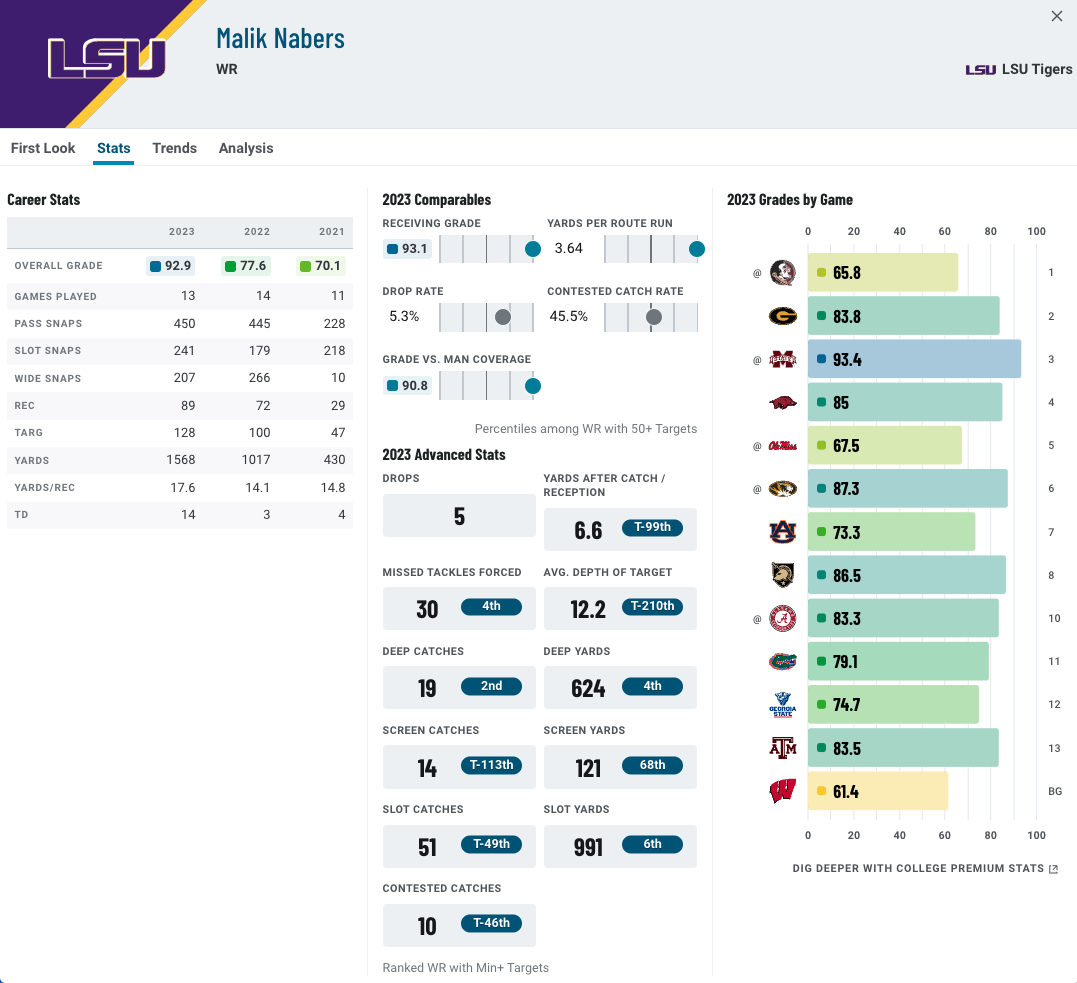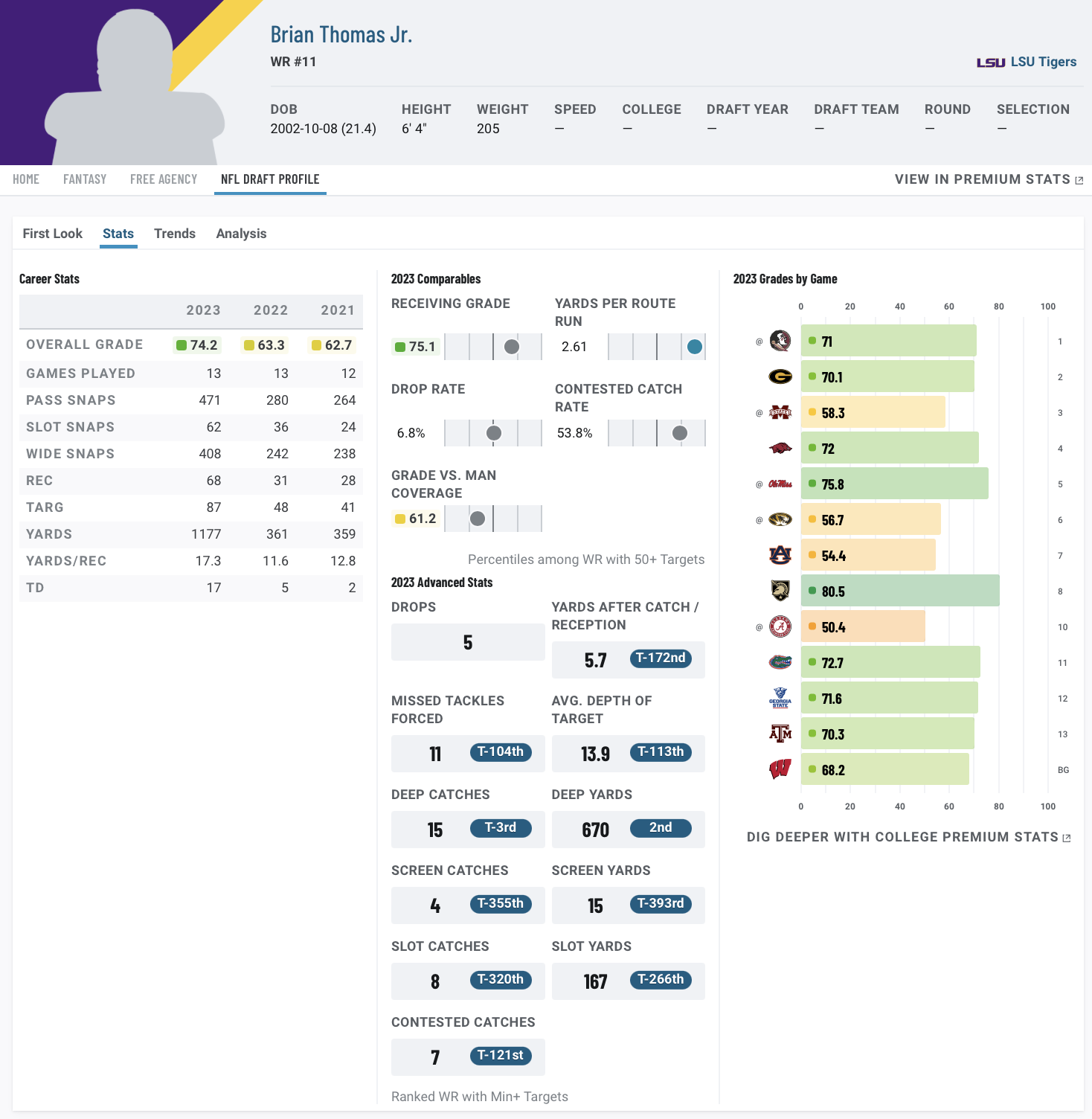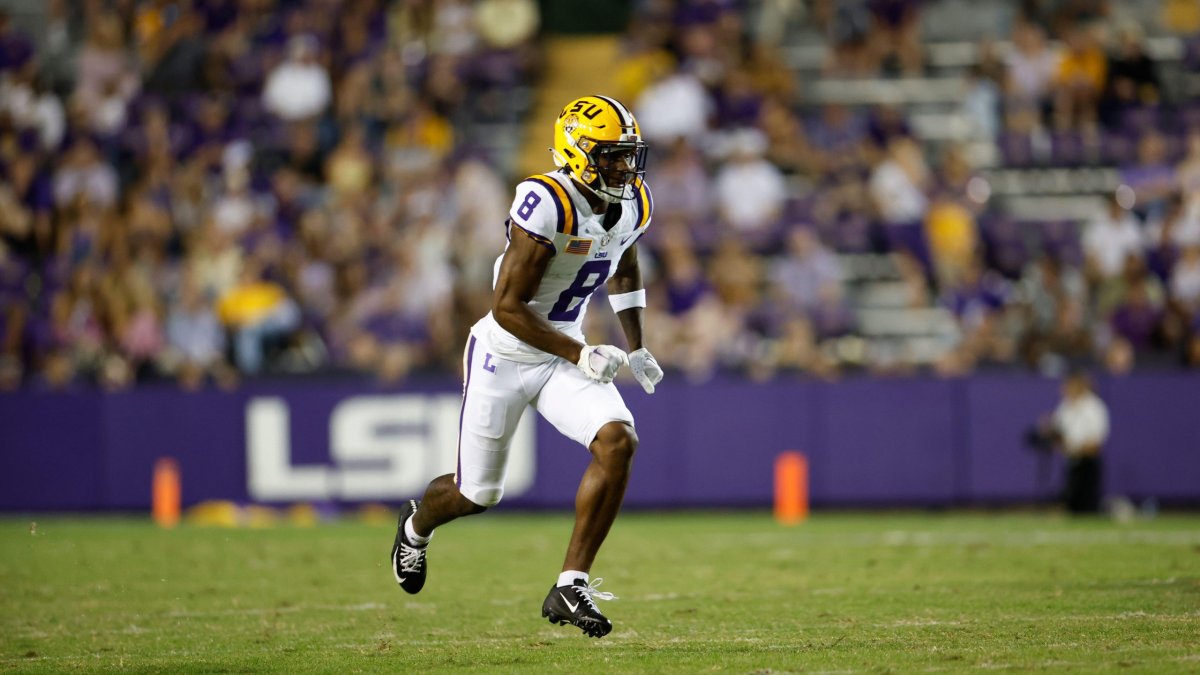• Marvin Harrison Jr. is elite: The Ohio State star ranks among the very best wide receiver prospects to come out in recent years.
• Malik Nabers isn’t far behind: Nabers' production profile provides plenty of confidence that he can be a top-10 pick in the 2024 NFL Draft.
• Try PFF's mock draft simulator: You can trade picks and players and draft up to five rounds for your favorite NFL team.
Estimated Reading Time: 10 minutes
Click here for more draft tools:
2024 Mock Draft Simulator | 2024 Big Board | 2024 Draft Guide
2024 Player Profiles | 2024 Mock Drafts | NCAA Premium Stats
There is a significant amount of excitement surrounding the 2024 NFL Draft's wide receiver class, especially at the top. With several potential top-10 wide receivers coming out this year, it’s worth diving into their production numbers from college to see how their analytical profiles compare to prospects of years past.
- Overall percentile rank is based on a model that includes a player’s yards per route run for their career, from specific alignments and against single coverage, as well as their best single-season marks. Also included are other stable metric categories, such as yards after catch per reception and separation rate, the latter of which has been adjusted to focus on targets deeper downfield.
- This model includes all wide receiver prospects over the past five years (since 2019).
- Strengths are considered production data points where a particular wide receiver scored the highest in comparison to the prospect pool dating back to 2019.
- Weaknesses are the areas where a particular wide receiver scored below the 50th percentile in that particular production category compared to the prospect pool since 2019.
- This article will be a spotlight on the top five wide receivers on the PFF big board. A look at some of the other standouts at the position using the same model is coming soon.
Marvin Harrison Jr., Ohio State
- No. 1-ranked wide receiver on the PFF big board
- 98th percentile production profile among college wide receiver prospects since 2019
Harrison is the top wide receiver prospect on many big boards, and for good reason. He posted dominant yards per route run and receiving grade figures for his college career, which puts him among some of the highest-scoring prospects in this college production model since 2019 — including Ja’Marr Chase, DeVonta Smith, Tee Higgins and CeeDee Lamb.
Harrison is in great company, as the group delivered a WR1 season in PPR points per game within 43% of those first four seasons. That elite group also delivered at least a WR2 season in 64% of their 14 combined seasons played in the NFL.
Below are just some of the standout data points from Harrison’s impressive career at Ohio State.
Harrison’s Career College Analytics Strengths
| Metric | Value | Rank Among WR Prospects Since 2019 |
| Yards per route run | 2.98 | 93rd percentile |
| Receiving grade | 91.3 | 94th percentile |
| Receiving grade lined up wide | 89.5 | 97th percentile |
| Receiving grade lined up in the slot | 89.9 | 94th percentile |
| Explosive play rate | 45.8% | 94th percentile |
| Receiving grade versus single coverage | 94.5 | 98th percentile |
There aren't many standout weaknesses for Harrison, though no prospect is perfect. His after-the-catch numbers were on the lower end of the spectrum compared to the wide receiver prospect pool since 2019. However, with so many other strengths, these scores are minor outliers when looking at his complete production profile.
Harrison’s College Analytics Weaknesses
| Metric | Value | Rank Among WR Prospects Since 2019 |
| Missed tackles forced per reception | 0.10 | 19th percentile |
| YAC/reception | 5.1 | 32nd percentile |
Malik Nabers, LSU
- No. 2-ranked wide receiver on the PFF big board
- 95th percentile production profile among college wide receiver prospects since 2019
Much like Harrison, Nabers performed incredibly well across the board, and when combining his key receiving metrics through his college career, he is comparable with the 95th percentile of wide receiver prospects since 2019. Nabers was one of the highest-graded wide receivers in college football in 2023, which only added to his already strong production from 2022.
Nabers' prospect score is among the best since 2019, but there start to be a few more fantasy misses in this range. Highly drafted names in this range include Treylon Burks, Rashod Bateman and Laviska Shenault. But the same group includes Garrett Wilson, Chris Olave and Drake London. The lowest-drafted name in this range also stands out: Puka Nacua, who broke through with his elite receiving production and bucked the trend of wide receivers scoring in this range going within the first 50 draft picks.
Nabers' Career College Analytics Strengths
| Metric | Value | Rank Among WR Prospects Since 2019 |
| Yards per route run | 2.83 | 87th percentile |
| Receiving grade | 91.2 | 93rd percentile |
| Receiving grade lined up in the slot | 90.5 | 96th percentile |
| Receiving grade versus single coverage | 93.4 | 96th percentile |
| Best single-season receiving grade | 93.1 | 99th percentile |
| Missed tackles forced per reception | 0.31 | 99th percentile |
Nabers' production numbers don’t show any true points of weakness. Instead, these can just be considered areas where he wasn’t elite. His yards per route run when lined up wide (2.52) ranks in the 71st percentile for his position, coming in lower relative to his many 90th-percentile-and-above scores.
The only area included in the production profile where Nabers scored below the 50th percentile was in open-target rate on throws 10 or more yards downfield. There have been first-round wide receivers to perform well in that category, such as Jaylen Waddle (48%), Garrett Wilson (47%), Chris Olave (47%) and Justin Jefferson (45%), with Nabers having seen more targets (131) than all but Olave (149) in that regard.
Nabers’ College Analytics Weaknesses
| Metric | Value | Rank Among WR Prospects Since 2019 |
| Adjusted separation rate (10+ yards ADoT) | 26% | 46th percentile |

Rome Odunze, Washington
- No. 3-ranked wide receiver on the PFF big board
- 90th percentile production profile among college wide receiver prospects since 2019
The top three 2024 wide receiver prospects all have elite production profiles. Odunze got progressively better and more productive across his four college seasons, culminating in an FBS-leading 1,639 receiving yards in 2023.
Odunze posted strong numbers against single coverage, including 4.17 yards per route run and a 92.1 receiving grade across 166 targets — the fourth most among wide receiver prospects since 2019. His high level of success against single coverage should only help his case in translating to the NFL.
As a big outside wide receiver, it was promising to see him earn high receiving grades from wide alignments. Odunze also boasts the highest career average depth of target (13.7) among the top three wide receivers in this year’s class, and while he doesn’t quite match up to Marvin Harrison Jr.’s 46% explosive play rate, he still posted strong production in that regard (40%).
Odunze’s Career College Analytics Strengths
| Metric | Value | Rank Among WR Prospects Since 2019 |
| Receiving grade | 88.8 | 82nd percentile |
| Receiving grade versus single coverage | 92.1 | 89th percentile |
| YPRR versus single coverage | 4.17 | 78th percentile |
| Receiving grade lined up wide | 85.8 | 89th percentile |
Odunze’s production weaknesses relative to the past five years of wide receiver prospects are similar to Harrison's: lower after-the-catch numbers. However, one area that stands out is Odunze’s best single-season yards per route run total, which sits in the 39th percentile of wide receiver prospects. This is not as much of a concern as his career yards per route run figure (2.50), which is a more stable metric. However, it still ranks in the 75th percentile of prospects.
Odunze’s College Analytics Weaknesses
| Metric | Value | Rank among WR prospects since 2019 |
| Best single-season YPRR total | 2.51 | 39th percentile |
| Missed tackles forced per reception | 0.15 | 46th percentile |
| YAC/reception | 5.2 | 36th percentile |
Brian Thomas Jr., LSU
- No. 4-ranked wide receiver on the PFF big board
- 41st percentile production profile among college wide receiver prospects since 2019
There is a significant production drop-off from the top three wide receivers on the PFF big board to the next two, starting with Thomas, who had to live in Nabers' shadow at LSU. That being said, 2023 was a significant breakout for Thomas, and his 1,177 receiving yards and 17 receiving touchdowns were nothing to scoff at, though still not quite at the same level as Nabers. There were only two key areas of production where Thomas cracked the 65th percentile of prospects since 2019, which isn’t much of a surprise since he only really delivered in his final college season.
Although Thomas beat out Nabers in touchdown receptions in 2023 (17 to 14), Thomas managed a first down or touchdown on just 11% of routes (37th percentile) compared to Nabers' 15% clip (89th percentile).
Thomas' Career College Analytics Strengths
| Metric | Value | Rank Among WR Prospects Since 2019 |
| Missed tackles forced per reception | 0.23 | 83rd percentile |
| Adjusted separation rate (10-plus yards ADoT) | 32% | 65th percentile |
Thomas' production profile includes several lower figures, including a 28th-percentile career yards per route run (1.95) — which, again, isn’t surprising for a one-year breakout. The concern comes with some of Thomas’ efficiency numbers, specifically yards per route run and targets per route run. Both numbers are quite low for a player who was able to crack the top 15 FBS wide receivers in yardage in 2023, which points to more volume-based production versus a combination of both volume and efficiency, which is ideal for first-round wide receivers.
Since 2019, there haven't been any first-round wide receivers with a production profile below the 50th percentile of prospects. Thomas is currently tracking toward being a first-round pick, and while several prospects with his profile became starting NFL players and fantasy assets, including Amon-Ra St. Brown, Nico Collins and Terry McLaurin, none were first-round picks. And there are still examples of highly drafted prospects who failed to succeed consistently in the NFL. Parris Campbell, Chase Claypool, Van Jefferson and potentially Jonathan Mingo stand out as Day 2 wide receivers with similarly low production profiles.
Thomas’ College Analytics Weaknesses
| Metric | Value | Rank Among WR Prospects Since 2019 |
| Yards per route run | 1.95 | 28th percentile |
| Targets per route run | 0.18 | 11th percentile |
| Receiving grade | 71.5 | 21st percentile |
| Best single-season receiving grade | 75.1 | 21st percentile |

Adonai Mitchell, Texas
- No. 5-ranked wide receiver on the PFF big board
- 27th percentile production profile among college wide receiver prospects since 2019
Mitchell, much like Thomas, boasts a weak production profile yet is tracking to be a first-round pick in this year’s draft. The appeal of Mitchell is his speed and athletic traits, which translated to some of his best data points in college football. Mitchell’s speed and athleticism allowed him to post a great explosive play rate, as he got open deep downfield and performed well against single coverage.
There are some promising traits to bank on for Mitchell to succeed in the NFL, assuming he continues to develop. However, looking at the big picture of his college production, a first-round pick may be a steep price to pay for that potential.
Mitchell’s Career College Analytics Strengths
| Metric | Value | Rank Among WR Prospects Since 2019 |
| Explosive play rate | 40.9% | 76th percentile |
| Receiving grade versus single coverage | 89.2 | 71st percentile |
| Adjusted separation rate (10-plus yards ADoT) | 40% | 82nd percentile |
The concerns with Mitchell are similar to that of LSU’s Thomas, in that his overall college career production just isn’t there. Mitchell was just a one-year starter at Texas after transferring from Georgia in 2023, and while he delivered 11 touchdowns, he failed to crack 900 yards in 14 games and was unable to command a better target share than teammate Xavier Worthy.
Mitchell’s numbers after the catch were particularly poor, including one of the worst yards after the catch per reception figures (3.0) of any wide receiver prospect since 2019. His 16.0-yard average depth of target in 2023 can explain that away to an extent, but it’s still a very low number for a potential first-round pick.
Standing out the most is his career yards per route run total, which ranks in the 13th percentile of wide receiver prospects since 2019 and would be, by far, the lowest total for any first-round wide receiver over that span, including Brian Thomas Jr. this year. Among 34 qualifying wide receivers who ranked in the bottom 15th percentile in career yards per route run since 2019, only Terry McLaurin has been a consistent top-36 fantasy wide receiver in points per game. Hunter Renfrow is the only other player in that range to hit that mark, and he did so just once in his five-year career.
Mitchell’s College Analytics Weaknesses
| Metric | Value | Rank Among WR Prospects Since 2019 |
| Yards per route run | 1.68 | 13th percentile |
| Targets per route run | 0.18 | 11th percentile |
| Missed tackles forced per reception | 0.10 | 15th percentile |
| YAC/reception | 3.0 | 1st percentile |
| Best single-season YPRR | 1.72 | 3rd percentile |
| Targets per route run | 0.19 | 12th percentile |




 © 2024 PFF - all rights reserved.
© 2024 PFF - all rights reserved.